Exporting User Information from Active Directory
With regards to dealing with customer accounts in Energetic Directory, probably the most important duties is exporting user data. Regardless of whether you need to make studies for auditing uses or simply want to monitor consumer information and facts, choosing the right active directory management tools strategy is essential. In this post, we will offer a complete guide to picking the right AD user export to meet your needs.
1. PowerShell Export: PowerShell is actually a potent device for handling Productive Website directory in Windows Host. Just about the most helpful options that come with PowerShell is the opportunity to export end user data with just a few directions. To use PowerShell for exporting end users, you’ll require the Lively Directory Module for Microsoft windows PowerShell set up on your server. When you have the element mounted, you can use the Get-ADUser cmdlet to get customer information and export it to a data file in a variety of formats, including CSV, Web coding, or XML.

2. CSVDE Export: When you want a graphical interface (GUI) for exporting consumer information, CSVDE (Comma Segregated Worth Data Exchange) can be a built-in utility in Home windows Host that allows you to export customer info to your CSV file. CSVDE makes use of LDAP to retrieve customer details from Active Website directory and will export details including username, private data (hashed), e-mail address, plus more. Be aware that the normal production file file format is CSV, but you can even use other document formats by specifying the file extension.
3. LDIFDE Export: Comparable to CSVDE, LDIFDE (LDAP Info Interchange File format Information Exchange) is another built in power in Microsoft windows Host that allows you to export end user information to some document. Even so, the main difference between CSVDE and LDIFDE is the fact that LDIFDE utilizes the LDAP Information Interchange Structure (LDIF) to hold and exchange website directory information. LDIFDE can export data including username, pass word, group of people account, and much more, and can be used for bulk functions such as importing or getting rid of a number of physical objects in Lively Listing.
4. Next-Bash Tools: If you want more advanced functions or customization alternatives for exporting end user details, there are also third-bash tools readily available which can help. For instance, some tools allow you to export data in various file formats or include more advanced inquiries to filtering information. Some well-liked next-party tools for exporting customer details from Lively Directory involve ManageEngine ADManager As well as, SolarWinds Access Rights Manager, and Pursuit ActiveRoles Host.
5. Considerations for Selecting the best Export Method: When selecting the best AD user export technique, there are various factors to consider. For example, you should look at the formatting and articles in the exported data, the level of changes possibilities needed, the ease of use, as well as the charge. PowerShell is an excellent alternative for those at ease with utilizing demand-series tools and wish overall flexibility and whole manage. CSVDE and LDIFDE are designed-in utilities that need no extra cost, but might have limitations regarding modification possibilities. Thirdly-bash equipment offer more functions and options, but need a price and could have a studying curve.
Simply Speaking:

Selecting the best AD user export method is a vital process in managing customer credit accounts in Energetic Listing. No matter if you favor a command-line device like PowerShell, a GUI application like CSVDE or LDIFDE, or possibly a thirdly-celebration resource with additional superior characteristics, there are actually available options to suit your needs. Think about factors like the format and articles from the exported information, the changes options, ease of use, and cost when picking out the correct means for your organization. With the proper AD user export device, you can actually and effectively export customer data in order to meet your revealing and auditing requirements.
Comments
Post a Comment